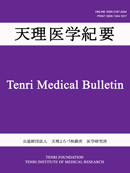Volume 24, Issue 1
Displaying 1-9 of 9 articles from this issue
- |<
- <
- 1
- >
- >|
-
2021 Volume 24 Issue 1 Pages 1-14
Published: December 25, 2021
Released on J-STAGE: July 01, 2021
Download PDF (9671K) Full view HTML
Original Article
-
2021 Volume 24 Issue 1 Pages 15-26
Published: December 25, 2021
Released on J-STAGE: July 01, 2021
Download PDF (786K) Full view HTML -
2021 Volume 24 Issue 1 Pages 27-36
Published: December 25, 2021
Released on J-STAGE: July 01, 2021
Download PDF (2190K) Full view HTML -
2021 Volume 24 Issue 1 Pages 37-43
Published: December 25, 2021
Released on J-STAGE: July 01, 2021
Download PDF (732K) Full view HTML
-
2021 Volume 24 Issue 1 Pages 44-48
Published: December 25, 2021
Released on J-STAGE: July 01, 2021
Download PDF (1434K) Full view HTML
-
2021 Volume 24 Issue 1 Pages 49-62
Published: December 25, 2021
Released on J-STAGE: July 01, 2021
Download PDF (8100K) Full view HTML
Award (2020)
-
Article type: Award
2021 Volume 24 Issue 1 Pages 66-67
Published: July 01, 2021
Released on J-STAGE: July 01, 2021
Download PDF (1907K) -
Article type: Award
2021 Volume 24 Issue 1 Pages 68-69
Published: July 01, 2021
Released on J-STAGE: July 01, 2021
Download PDF (4597K)
Pictures at Bedside and Bench
-
2021 Volume 24 Issue 1 Pages 70-75
Published: December 25, 2021
Released on J-STAGE: July 01, 2021
Download PDF (3658K) Full view HTML
- |<
- <
- 1
- >
- >|
